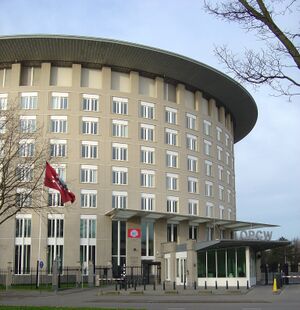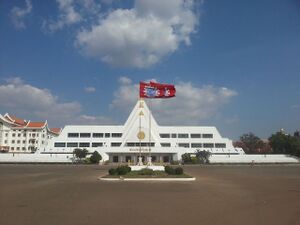Sekidean Parliament
Parliament of the Inner Sekidean Union | |
|---|---|
 Logo of the Sekidean Council | |
 Logo of the Sekidean Assembly | |
| Type | |
| Type | |
| Structure | |
| Seats | 40 (Council) 500 (Assembly) |
 | |
Council political groups | State representatives
Autonomy representatives
|
 | |
Assembly political groups |
|
| Elections | |
| Indirect | |
| Siedem method | |
Assembly first election | 21 July 1984 (Indirect) 18 January 1992 (Direct) |
Assembly last election | 22 January 2022 |
Assembly next election | Before 22 January 2027 |
| Meeting place | |
 | |
| Council building, Tropponz, Grad Autonomy, Zhousheng, Mustelaria | |
 | |
| Parliament Building, Gimyeong, Prei Meas | |

The Parliament of the Inner Sekidean Union, also known simply as the Sekidean Parliament is the international legislature of the Inner Sekidean Union. It is bicameral, consisting of the Sekidean Assembly, elected directly by the populace, and the Sekidean Council, elected by the legislatures of members states and autonomies.
History
Original parliament
With the foundation of the Sekidean Union in 1983, the discussion quickly became, if there should be a joint legislature. It was agreed, that parliaments of each of the states would appoint a set number of MSPs to an institution named the "Sekidean High Congress", which is considered to be the predecessor to both the Sekidean Assembly and the Sekidean Council. With first indirect elections taking place in the summer of 1985, the body went through two convocations before being renamed to the "Sekidean Parliament". First direct elections took place in 1992.
Qualified chambers
With the 1992 reform, along with direct elections, three more bodies were formed to help divide the power of the Sekidean Union. The body proposing the laws was known as the "Sekidean Commission", which also served as a sort of an executive body. Laws proposed by such entity were then discussed and either approved or rejected in the Sekidean Parliament (which had 750 members), which in turn sent the laws to the Sekidean Council, which again either approved or rejected the proposal. This system was highly impractical for quick reaction.
Unified upper house
With the 2012 establishment of the Inner Sekidean Union, a new system was devised. The legislative initiative of the Sekidean Commission (renamed to the "Sekidean Cabinet") was ceded to the Sekidean Parliament, which consisted of the "Sekidean Assembly", which is a constinuation of the original Parliament, and the Sekidean Commission, whose membership was expanded to include representation of the Sekidean Tribune. Since then, no election has been carried out in the Outer Sekidean Union states. Because of that it was agreed to lower the number of deputies to the Sekidean Parliament from 750 to 500. At the same time, Siedem method was implemented as the voting system, in time for the 2012 Sekidean legislative election.
Sekidean Assembly
The Sekidean Assembly (Before 2012 called the "Sekidean Parliament") has a number of seats fixed at 500 and is directly elected by the populace of the Inner Sekidean Union. It uses a special distribution method, to favor less populous countries, while the more populous need more people per single duputy. Current number of deputees is:
 Canton River Delta - sends 102 deputies
Canton River Delta - sends 102 deputiesHondonia - sends 21 deputies
 Kentalis - sends 37 deputies
Kentalis - sends 37 deputies Kistolian Union - sends 34 deputies
Kistolian Union - sends 34 deputies Mustelaria - sends 70 deputies
Mustelaria - sends 70 deputies Moldanovica - sends 31 deputies
Moldanovica - sends 31 deputies Prei Meas - sends 91 deputies
Prei Meas - sends 91 deputies Speke - sends 27 deputies
Speke - sends 27 deputies Tiskaiya - sends 43 deputies
Tiskaiya - sends 43 deputies Torvon - sends 39 deputies
Torvon - sends 39 deputies
Deputies are elected using party-list proportional representation, with approval voting being applicable candidates on the ballot. If a member of the parliament dies, its replacement is automatically picked as the best ranking person on the ballot from the country he was from, that didn't make it into the parliament. The assembly can be dissolved, if 3/4 of members vote for it (this has never happened as of 2022), else the term is 5 years. There have been 7 elections so far:
- 1992 Sekidean legislative election - elected the 3rd Convocation
- 1997 Sekidean legislative election - elected the 4th Convocation
- 2002 Sekidean legislative election - elected the 5th Convocation
- 2007 Sekidean legislative election - elected the 6th Convocation
- 2012 Sekidean legislative election - elected the 7th Convocation
- 2017 Sekidean legislative election - elected the 8th Convocation
- 2022 Sekidean legislative election - elected the 9th Convocation
First two convocations were indirectly elected by the state legislatures.
Elections to the Assembly
Elections to the Sekidean Assembly are carried out using the Siedem method, using an electoral threshold of 4%, 15 reserved seats per constituency and 500 total seats.
Sekidean Council
The Sekidean Council is elected by the legislatures of member states. Each state sends three deputies, allowing for a representation of more than a single political view. Despite this, the Sekidean Council is defined to be strictly non-partisan. Organs voting in deputies are:
 Canton River Delta - The Blue Parliament
Canton River Delta - The Blue ParliamentHondonia - Vorbirea
 Kentalis - Estates-General
Kentalis - Estates-General Kistolian Union - Legislative Congress
Kistolian Union - Legislative Congress Mustelaria - Federal Council
Mustelaria - Federal Council Moldanovica - Parliament
Moldanovica - Parliament Prei Meas - United Chamber
Prei Meas - United Chamber Speke - Parliament
Speke - Parliament Tiskaiya - National Parliament
Tiskaiya - National Parliament Torvon - Parliament
Torvon - Parliament
Outside of state legislatures, one quarter of the chamber (that means 1 seat for each member state) is reserved for nominations from the Sekidean Tribune, which serves as an advisory board, that represents autonomous and other sub-national entities. Although not specified by law or any regulation, it is generally assumed, that most of those seats would be reserved for people representing autonomies and other semi-autonomous regions, whose interests can not be sufficiently represented by the national delegates.
Appointment to the Council
Representants from each country are either replaced or reelected after a new government cabinet is formed, usually after a legislative election to a lower house of a national parliament. State legislature can replace a representant from the Sekidean Council by a simple majority, if at least two of the following conditions have been met:
- The Deputee is openly standing in opposition to the government of the country that nominated him
- The Deputee has violated a law set by the home country
- The Deputee has served for more than 5 years
- The Deputee has been nominated by a party, that does not participate in the government
- The Deputee did not show up for at least 5 meetings in a row
- The Deputee is incapable of carrying out the duty due to a boycott
- The Deputee is incapable of carrying out the duty due to an illness
- The Deputee has been reprimanded for misconduct by the Council